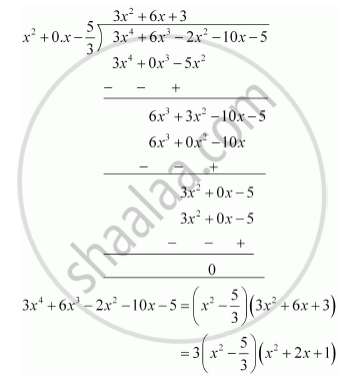Advertisements
Advertisements
प्रश्न
Obtain all other zeroes of 3x4 + 6x3 – 2x2 – 10x – 5, if two of its zeroes are `sqrt(5/3)` and - `sqrt(5/3)`
उत्तर
p(x) = 3x4 + 6x3 – 2x2 – 10x – 5
Since the two zeroes are sqrt(5/3) and – sqrt(5/3).
∴ `(x-sqrt(5/3))(x+sqrt(5/3)) = (x^2-5/3)` is factor of 3x4+6x3-2x2-10x-5
Therfore, we divide the given polynomial by x^2-5/3

we factorize x2+2x+1
=(x+1)2
Therefore, its zero is given by x+1=0
x = -1
As it has the term (x + 1)2 , therefore, there will be 2 zeroes at x = – 1.
Hence, the zeroes of the given polynomial are `sqrt(5/3)` and – `sqrt(5/3)` , – 1 and – 1
APPEARS IN
संबंधित प्रश्न
Check whether the first polynomial is a factor of the second polynomial by dividing the second polynomial by the first polynomial
x3 – 3x + 1, x5 – 4x3 + x2 + 3x + 1
Give examples of polynomials p(x), g(x), q(x) and r(x), which satisfy the division algorithm
deg p(x) = deg q(x)
Apply division algorithm to find the quotient q(x) and remainder r(x) on dividing f(x) by g(x) in the following f(x) = 4x3 + 8x2 + 8x + 7, g(x) = 2x2 − x + 1
Obtain all zeros of the polynomial f(x) = x4 − 3x3 − x2 + 9x − 6, if two of its zeros are `-sqrt3` and `sqrt3`
Show that every positive odd integer is of the form (4q +1) or (4q+3), where q is some integer.
Find the quotient and remainder of the following.
(8y3 – 16y2 + 16y – 15) ÷ (2y – 1)
Find the quotient and remainder of the following.
(8x3 – 1) ÷ (2x – 1)
The area of a rectangle is x2 + 7x + 12. If its breadth is (x + 3), then find its length
The base of a parallelogram is (5x + 4). Find its height if the area is 25x2 – 16
What will the quotient and remainder be on division of ax2 + bx + c by px3 + qx2 + rx + s, p ≠ 0?
